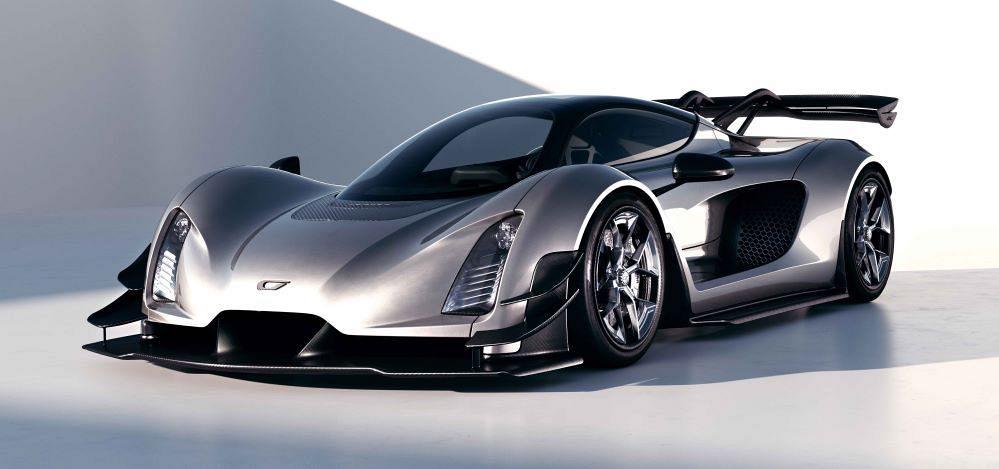- FMA
- The Fabricator
- FABTECH
- Canadian Metalworking
Our Publications
Categories
- Additive Manufacturing
- Aluminum Welding
- Arc Welding
- Assembly and Joining
- Automation and Robotics
- Bending and Forming
- Consumables
- Cutting and Weld Prep
- Electric Vehicles
- En Español
- Finishing
- Hydroforming
- Laser Cutting
- Laser Welding
- Machining
- Manufacturing Software
- Materials Handling
- Metals/Materials
- Oxyfuel Cutting
- Plasma Cutting
- Power Tools
- Punching and Other Holemaking
- Roll Forming
- Safety
- Sawing
- Shearing
- Shop Management
- Testing and Measuring
- Tube and Pipe Fabrication
- Tube and Pipe Production
- Waterjet Cutting
Industry Directory
Webcasts
Podcasts
FAB 40
Advertise
Subscribe
Account Login
Search
Hypercar features more than 350 3D-printed parts
3D-printed parts play a key role in California company’s superfast $2 million car
- By Kip Hanson
- March 4, 2022
- Article
- Additive Manufacturing

Lukas Czinger (left) and his father, company founder Kevin Czinger, stand by the hypercar bearing their name. Images: Czinger Vehicles
Stories of 3D-printed automobile parts like shifter knobs and bespoke cupholders have become common of late. Such examples illustrate that additive manufacturing is gaining steam in the automotive market.
Then there are vehicles that don’t stop at cupholders, like the Czinger 21C. It has more than 350 printed parts and, thanks to digital manufacturing methods, goes from zero to damn fast in a fraction of the time it takes to put most vehicles on the road.
Hyped Up
In 2014, former hotrod-builder-turned-entrepreneur Kevin Czinger founded Divergent 3D, a manufacturing firm focused on sustainable production methods. Five years later, he launched Czinger (pronounced “zinger”) Vehicles, an automotive company whose vehicles “express the cutting edge of the human mind.”
One year later, in 2021, Czinger Vehicles introduced the extremely cool tandem-seat 21C.
Boasting 1,250 HP and a dry weight under 2,700 lbs., the all-wheel-drive 21C achieves a true 1:1 power-to-weight ratio. Its hybrid powertrain includes a 2.88-liter, twin-turbo, flat-crank V-8 engine with electric motors driving each front wheel and an electric system that can add 100 HP to the rear wheels.
These and other performance features reportedly allow the vehicle to go from 0 to 62 MPH in 1.9 seconds, run the quarter-mile in 8.1 seconds, and reach a top speed of 281 MPH.
As noted, it’s damn fast.
Kevin Czinger and his team, which includes his son, Czinger Vehicles’ co-founder Lukas Czinger, designed, built, and manufactured the 21C at the company’s facility in Los Angeles. It’s no coincidence that Divergent 3D shares the same address.
Michael Kenworthy has allegiance to both companies. His primary role is CTO of additive manufacturing technologies at Divergent, but he also oversees the extensive metal 3D printing that Czinger Vehicles “outsources” to Divergent. (Among the metal printers Divergent 3D operates are 12-laser NXG XII 600 systems from SLM Solutions.)
Divergent is not a captive shop, however. Kenworthy and his co-workers design and produce parts for other high-end vehicle manufacturers. He’s not at liberty to say which ones (yet), but is quick to point out that Divergent’s development cycles are far faster than what the automotive industry has long deemed acceptable.
Soothing Pain Points
The foundation of Divergent 3D’s approach to building cars is the Divergent Adaptive Production System. A complete software/hardware solution designed to replace traditional vehicle manufacturing, DAPS “radically transforms auto manufacturing economics and environmental impact using a data-driven approach for designing and building vehicle structures,” says the carmaker.
“Kevin Czinger realized long ago that tooling is the auto industry’s main pain point,” said Kenworthy. “He set out to combine several digital manufacturing technologies that would basically erase that pain point and create a tool-less manufacturing system. DAPS is built on a software design suite that we developed, automated assembly capabilities, and, most especially, additive manufacturing. This is what allows us—and by extension, Czinger [Vehicles]—to design and produce automobile components at a speed and price point never before seen in the automotive industry.”
As for the price point for a 21C, it’s $2 million. Production will be limited to 80 cars. They’re scheduled to begin shipping in 2023, if you’re interested.
About the Author

Kip Hanson
About the Publication
- Podcasting
- Podcast:
- The Fabricator Podcast
- Published:
- 04/16/2024
- Running Time:
- 63:29
In this episode of The Fabricator Podcast, Caleb Chamberlain, co-founder and CEO of OSH Cut, discusses his company’s...
- Trending Articles
- Industry Events
16th Annual Safety Conference
- April 30 - May 1, 2024
- Elgin,
Pipe and Tube Conference
- May 21 - 22, 2024
- Omaha, NE
World-Class Roll Forming Workshop
- June 5 - 6, 2024
- Louisville, KY
Advanced Laser Application Workshop
- June 25 - 27, 2024
- Novi, MI




























